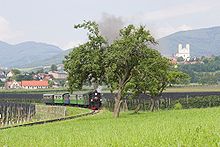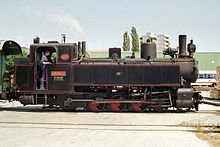Feistritztalbahn
| Weiz – Birkfeld – rats | |||||||||||||||||||||||||||||||||||||||||||||||||||||||||||||||||||||||||||||||||||||||||||||
|---|---|---|---|---|---|---|---|---|---|---|---|---|---|---|---|---|---|---|---|---|---|---|---|---|---|---|---|---|---|---|---|---|---|---|---|---|---|---|---|---|---|---|---|---|---|---|---|---|---|---|---|---|---|---|---|---|---|---|---|---|---|---|---|---|---|---|---|---|---|---|---|---|---|---|---|---|---|---|---|---|---|---|---|---|---|---|---|---|---|---|---|---|---|
| Route length: | 42.2 km | ||||||||||||||||||||||||||||||||||||||||||||||||||||||||||||||||||||||||||||||||||||||||||||
| Gauge : | 760 mm ( Bosnian gauge ) | ||||||||||||||||||||||||||||||||||||||||||||||||||||||||||||||||||||||||||||||||||||||||||||
|
|||||||||||||||||||||||||||||||||||||||||||||||||||||||||||||||||||||||||||||||||||||||||||||
The Feistritztalbahn is a narrow-gauge railway with a track width of 760 mm in Styria , which still runs from Weiz to Birkfeld today .
history

The Weiz – Birkfeld railway line operated today by Feistritztalbahn Betriebs-GmbH was opened on December 14, 1911 (after the original deadline, October 1, 1911, could not be met). The original local railway company Weiz – Birkfeld commissioned the kk Österreichische Staatsbahnen to manage the railway line. The connection to the standard-gauge network takes place at Weiz station, the end point of the standard-gauge Landesbahn Gleisdorf – Weiz . Until December 2014, the Steiermärkische Landesbahn maintained freight traffic between Weiz and Oberfeistritz.
The construction of the continuation after Ratten began during the First World War , but had to be stopped again due to a lack of workers. In 1922 , the section was put into operation as a tow to the brown coal mine in Ratten. Feistritz-Bergbau- und Industrie AG had already taken over the construction a year earlier and committed to convert the Birkfeld – Ratten – Rettenegg line from an industrial railway to a public, narrow-gauge local railway for passenger and public transport by February 25, 1931 at its own expense To design freight traffic. Since the line to Ratten was only built as an industrial line, it was not possible to run direct trains from Ratten beyond Birkfeld despite the same gauge because of different brake and clutch systems. This resulted in two reloading for coal transports (in Birkfeld and Weiz) before the coal could be transported further in standard-gauge freight wagons. High transport costs were the result.
On May 29, 1930, the industrial towing railway Birkfeld-Ratten acquired by the state of Styria, now expanded as a public railway line and connected to the Weiz-Birkfeld local railway, was opened to traffic by Federal President Wilhelm Miklas (1872–1956). A further construction to Rettenegg , which had been considered as early as 1913, which would have made it possible to reach the Südbahn in Steinhaus am Semmering at least for goods transport through the connection to the Feistritzwaldbahn, which had existed since 1902 , was never realized, nor was the construction of a line planned in Lower Austria that same year from Edlitz on the Aspangbahn to the Styrian border near Trattenbach and, from this point, a possible connection with the Feistritzwaldbahn that is less than two construction kilometers.
In 1942 the railway company became the property of what was then Reichsgau Styria and thus after the Second World War to the Styrian State Railways. The closure of the mine in Ratten in 1960 led to the loss of the main goods customer in Ratten, and general motorization to the decline in passenger numbers. Nevertheless, the state railways endeavored to modernize operations by using diesel locomotives from the VL 11-16 series and new freight cars.
In 1971, as with the Murtalbahn, a regular slow train service with steam locomotives was introduced, which quickly became an integral part of the region's tourist offer.
After the suspension of public transport in the Birkfeld – Ratten section (February 28, 1971) and Weiz – Birkfeld (June 2, 1973) and the removal of the tracks from Birkfeld to Ratten (1981), the slow train service has been operated by the “Club U44, Friends the Feistritztalbahn "organized. Freight traffic in the Weiz - Oberfeistritz section was operated according to schedule until August 15, 2015 , the most important freight was talc from the opencast mining in the Rabenwald of Luzenac Naintsch Mineralwerke , which belongs to the Rio Tinto Group .
The route leads through three tunnels and over some striking viaducts. The longest of these, the Grubviadukt, is 276 meters long.
Private initiatives suggest resuming passenger traffic on the Feistritztalbahn, as five school buses and commuter buses are run in close succession and transport by train would be more practical and faster.
Currently, there are plans to put the Feistritztalbahn with its bridges, tunnels and well-preserved train stations under monument protection.
At the end of April 2019, an investor announced that it would use the Feistritztalbahn as a test track for new technologies in the rail vehicle industry. A resumption of passenger traffic from 2024 at the earliest is also planned. "Tram-like sets" are to be used.
Traction vehicles
Feistritztalbahn / Club U44
- Steam locomotive Kh.101 * - was subjected to a general inspection in Jenbach at the Zillertalbahn and has been in use since the 2013 season. Currently shut down due to boiler damage.
- Steam locomotive 83 180 (ex- JDŽ ) - not ready for operation, parked in Birkfeld
- Steam locomotive U.44 * - is dismantled in the boiler house Birkfeld.
- Steam locomotive U.8 * - is ready for use in Birkfeld
- Steam locomotive U.7 - is dismantled for later processing in Oberfeistritz; individual parts of the locomotive in Birkfeld.
- Diesel locomotive JW 200 - ready for operation in Weiz (blue paint)
- Diesel locomotive Jung - ready for operation in Birkfeld (orange paint)
- Draisine 616.912 (ex ÖBB ) - ready for operation in Birkfeld (yellow paint)
* rented vehicles owned by the Steiermärkische Landesbahnen
STLB
- Diesel locomotive VL 16 - (rented from the FTB) not ready for operation in Birkfeld (orange paintwork)
- Diesel locomotive VL 15 - parked in Weiz (orange paint with light blue roof)
- Diesel locomotive VL 14 - parked in Weiz (orange paint)
- Diesel locomotive VL 12 - (rented from the FTB) ready for operation in Birkfeld (red-green-white paintwork)
- Diesel locomotive VL 11 - parked in Weiz (orange paint)
- Diesel locomotive VL 22 (ex-JD®, equipped with radio remote control) - transferred to Murau (red-green-white paintwork)
- Diesel locomotive VL 23 (ex-JDŽ) - transferred to Murau (orange paint with green belly band)
- Diesel locomotive VL 8 - ready for operation in Weiz (orange paint)
- Diesel locomotive RT 3 - in Weiz (red-green-white paintwork)
- Draisine X44 - ready for use in Weiz (red paint with blue roof)
Quotes
The Grazer Morgenpost wrote the following about the opening of the Feistritztalbahn on December 12, 1911:
“From Birkfeld they write to us from 10. d. M. among other things: The station is ready and done! Today one reads in the daily newspapers that the opening of the local railway will finally be on the 14th day M. should take place [...]. A strong, tireless committee works with care and diligence; various decorations have been completed, the invitations have been written and only await the setting of the final day of the opening. May the first train come around the corner very soon and its whistle will find its echo in the mountains of Birkfeld, so that the excited minds can calm down again and give Birkfeld's familiar Alpine corner new life and new traffic! "
Web links
- Website of the Weiz tourist office about the Feistritztalbahn
- Website of Club U44, Friends of Feistritztalbahn
- Website of the Steiermärkische Landesbahnen about the Feistritztalbahn
- The Feistritztalbahn on the website of Bahnerlebnis Steiermark
Individual evidence
- ↑ The Feistritztalbahn Weiz – Anger – Birkfeld. In: Grazer Volksblatt , morning edition, No. 197/1911 (XLIV. Year), April 30, 1911, p. 5, top left. (Online at ANNO ). .
- ↑ Daily reports. The first train to Birkfeld. In: Grazer Volksblatt , morning edition, No. 572/1911 (XLIV. Year), December 15, 1911, p. 4, top right. (Online at ANNO ). .
- ↑ From the Alpine countries. Styria. (...) Weiz, July 23. In: Neues Grazer Tagblatt , first morning edition, No. 511/1921 (XXXIth year), July 30, 1921, p. 4 middle. (Online at ANNO ). .
- ↑ Manfred Hohn : “8. The coal railway Birkfeld-Ratten and the railways at the Bergbauen Kogl, St. Kathrein and Ratten. "In:" Feldbahnen in Österreich. "Leykam, Graz 2011, ISBN 978-3-7011-7766-0 , pp. 72 and 84.
- ↑ (caption :) The grand opening of the Birkfeld – Ratten railway line. (...). In: Wiener Bilder , No. 23/1930 (XXXV. Volume), June 8, 1930, p. 27. (Online at ANNO ). .
- ↑ rats. Railway Day. In: Grazer Volksblatt , morning edition, No. 484/1913 (XLVI. Volume), October 21, 1913, p. 8, column 1. (Online at ANNO ). .
- ↑ the digital railway photo archive ( page no longer available , search in web archives )
- ↑ kleinezeitung.at
- ↑ "So-it-goes-with-the-Feistritztalbahn."
- ↑ General inspection ( memento from June 4, 2015 in the Internet Archive ) of the Kh.101 steam locomotive
- ↑ Alfred Niel: “From steam horse to electric locomotive. The railroad in Austria ”. Styria Verlag, Graz 1987, ISBN 3-222-11745-4 .
Remarks
- ↑ Incorrect reference to the source: The Grazer Morgenpost stopped its publication on December 31, 1904. - See: The “Grazer Morgenpost” (...). In: Grazer Volksblatt , morning edition, No. 1/1905 (XXXVIIIth year), January 1, 1905, p. 3, center right. (Online at ANNO ). as well as the general catalog , Austrian Library Association .
Coordinates: 47 ° 15 ′ 41 ″ N , 15 ° 42 ′ 51 ″ E



